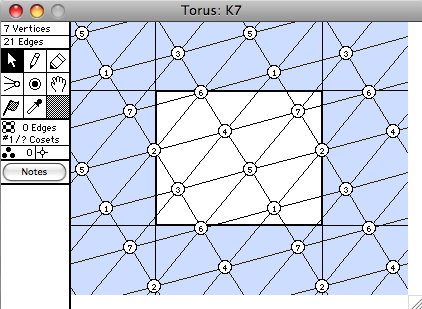Last update=28 January, 2009


A torus map is an embedding of a graph on the torus. Above is a typical torus map window containing an embedding of K7 on the torus. The torus is represented as a rectangle in which opposite sides have been identified, the "torus rectangle". Edges wrap around the torus when they cross the rectangle's boundary. A torus window shows the torus rectangle in the central region, surrounded by a larger rectangle, in order to make it easier to edit the graph, and to visualize the faces, and the wrapping of the edges. The vertices of the torus map all appear in the torus rectangle. Copies of them appear as "ghost" nodes in the larger rectangle. Torus maps are required to be 2-connected, 2-cell embeddings at all times. Loops and multiple edges are supported to some extent. A vertex v can have up to 3 loops, if they all wrap around the torus in different directions. Similarly, vertices u and v can be connected by up to 4 multiple edges, if they all wrap in different directions.
- The arrow tool is for selecting and moving nodes.
- The pencil is for editing the graph, edges are added or deleted as the pencil clicks from node to node. The graph must always remain 2-connected when edges are deleted.
- The fat pencil is for editing the bold subgraph. It adds or deletes thick edges as the mouse is clicked
- The sputnik creates a new node attached to all currently selected nodes, at the point where the mouse is clicked. It is a good idea to attach a new node to at least 3 nodes, or the new node may not be placed in the face you want.
- The bullet tool cannot be used with the torus, as the resulting graph would not be 2-connected.
- The hand moves the graph within the window.
- The flag selects and highlights a face of the torus map.
- The thermometer is not available for torus maps.

Torus Functions Available in G&G 3.0
Dual Map
Construct the dual map whose vertices correspond to the faces of the original map.Graph Layout
Given a torus map, find a layout of the vertices with no edges crossing.Medial Digraph
The faces of a torus map X are determined by the cyclic ordering of the edges incident on each node. This is called a rotation system for the graph. The torus is viewed as an oriented surface. The medial digraph is formed by representing each vertex and edge of X by a new vertex. Loops are represented by 2 new vertices. Directed cycles in the medial digraph are used to encode the rotation system of X. The result is a digraph whose isomorphism type uniquely determines the embedding of X on the torus.Automorphism Group
The automorphism group Aut(X) of a torus map is the group of permutations of the vertices that preserves the rotation system of X. It is computed via the medial digraph.
Truncate Corners
Every vertex of X is truncated -- that is, if deg(v)=k, then v is replaced by a cycle of k new vertices. The result is a new torus map.Flip Torus
Since the torus is an oriented surface, it can be "flipped" (ie, turned inside out). This will reverse the rotation system of a graph X embedded on the torus, to give a torus map X'. Given X, this item constructs X'. If X and X' are isomorphic as torus maps, then the map X is unorientable. If X and X' are non-isomorphic as maps, then they are orientable.Rotate Torus
This item rotates the graph X drawn on the torus by 90 degrees, either clockwise or counterclockwise. This is a homeomorphism of the torus producing an isomorphic embedding.Twist Torus
This item cuts the torus along either its right or bottom edge, gives it a single twist (a 360 degree turn), and glues it back together. This is called a "Dehn twist". It produces a homeomorphism of the torus which is not an isotopy. Graphs embedded on the torus which are related by a Dehn twist are considered isomorphic, even though they may look quite different on the screen, and it may not be possible to transform one into the other by a continuous deformation of the torus.Convert Planar Graph to Torus Map
Given a graph X which G&G knows to be planar, G&G will convert X to a torus map.
 Back to the Groups & Graphs home page.
Back to the Groups & Graphs home page.